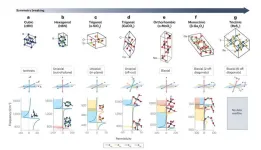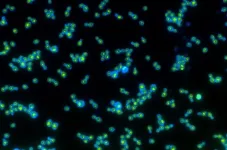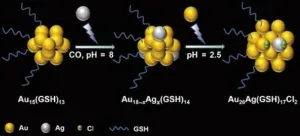(Press-News.org) Ethylene is sometimes called the most important chemical in the petrochemical industry because it serves as the feedstock for a huge range of everyday products. It’s used in the production of antifreeze, vinyl, synthetic rubber, foam insulation, and plastics of all kinds.
Currently, ethylene is produced through an energy- and resource-intensive process called steam cracking, where extremes of temperature and pressure produce ethylene from crude oil in the presence of steam—and in the process, emit tons of carbon dioxide into the atmosphere. Another way in which ethylene can be produced, however, is through a process called oxidative coupling of methane (OCM). It has the potential to be a greener alternative to steam cracking, but until recently, the amount of ethylene it yields did not make the process economically viable.
“So far, the catalytic yield has been below 30 percent for a single pass, meaning just passing the methane and oxygen through the catalyst and getting ethylene on the other side,” says Bar Mosevitzky Lis, a postdoctoral research associate in the Department of Chemical and Biomolecular Engineering in Lehigh University’s P.C. Rossin College of Engineering and Applied Science. “Studies that have simulated the entire industrial process using OCM have shown that the technology doesn’t become profitable until the single pass yield reaches between 30 and 35 percent.”
OCM is now one step closer to leaving the lab and entering the real world. For the first time, researchers at North Carolina State University (NCSU) and Lehigh University, in collaboration with researchers from the Guangzhou Institute of Energy Conversion and the East China University of Science and Technology, have developed an OCM catalyst that exceeds 30 percent when it comes to the production of ethylene. The paper describing their breakthrough was recently published in Nature Communications.
The collaboration was led by Fanxing Li, Alcoa Professor of Engineering at NCSU. His team developed a class of core-shell Li2CO3-coated mixed rare earth oxides as catalysts for the oxidative coupling of methane using a chemical looping scheme. The result was a single-pass yield of up to 30.6 percent.
“The idea with chemical looping is that instead of doing a co-feed of methane and oxygen into the chamber with the catalyst, you do it sequentially,” says Mosevitzky Lis, who is also one of the study’s coauthors. “Over time, you lose oxygen from the catalyst and it becomes ineffective. With chemical looping, you start with methane, then switch to oxygen, then back to methane, and the oxygen serves to continually reoxidize the catalyst, thereby replenishing its ability to provide oxygen for the reaction.”
Mosevitzky Lis and his team at Lehigh—led by Israel Wachs, G. Whitney Snyder Professor of Chemical and Biomolecular Engineering and Director of the Operando Molecular Spectroscopy and Catalysis Research Lab—did the characterization of the catalyst.
“Our specialization is with in situ surface characterization,” says Mosevitzky Lis, “meaning we characterize the surface of catalysts while the reaction is running. We apply a wide array of physical and chemical techniques to understand the transformations catalysts undergo while the catalytic reaction is running on their surface and how these transformations relate to what makes them such good catalysts.”
He says the catalyst is composed from a mixed oxide core covered by lithium carbonate, and it’s the interaction between the core and the shell during chemical looping that is responsible for the high yield. The results mean that, for the first time, upgrading methane—which can be found in natural gas and biogas—into ethylene could be within reach for industry.
“OCM has the potential to be cheaper and more efficient when it comes to energy and emissions,” he says. “Plus, instead of using crude oil, you’re using methane that typically comes from natural gas but may also be generated in the future from biogas and the electrochemical reduction of carbon dioxide. And once you have ethylene, you’re able to transform it into countless products that are used by the whole world.”
The next step is to determine the suitability of the catalyst for industrial scale production while trying to push the yield even further up. For now, however, having finally improved on a method that’s remained an unfulfilled promise since the 1980s marks a milestone.
“The intricacy of the system and the dynamics that take place, it’s almost like art,” says Mosevitzky Lis. “Both the core and the shell of the catalyst undergo very extreme processes, generating all kinds of interesting things on the surface. It’s beautiful.”
Related Links:
Nature Communications: "Lithium carbonate-promoted mixed rare earth oxides as a generalized strategy for oxidative coupling..."
Rossin College Faculty Profile: Israel E. Wachs
Lehigh University: Operando Molecular Spectroscopy and Catalysis Research Lab
NC State University: Li Research Group END
Core-shell ‘chemical looping’ boosts efficiency of greener approach to ethylene production
Multi-university team, including researchers from Lehigh University, reports catalysis breakthrough that could support oxidative coupling of methane (OCM) as an economically viable, more sustainable method for producing the essential chemical feedstock
2024-01-12
ELSE PRESS RELEASES FROM THIS DATE:
Targeting Microbiota 2024: Shaping the future of medicine – International leaders unite at the 11th World Congress
2024-01-12
The International Society of Microbiota (ISM) is pleased to announce its 11th World Congress, Targeting Microbiota 2024. This congress is scheduled to take place on October 17-18 in Malta, and will convene international leading experts, researchers, and professionals to explore and discuss the latest advancements in the field of microbiota. Under the new presidency of Maria Cecilia Giron, University of Padova, we anticipate a transformative era, propelling the ISM to new heights in microbiota research.
Thorough Investigation through Specialized Tracks
Recent Advances & Challenges in Microbiota
Microbiota-Host Cross-Talk and Signaling
Metabolomics: Innovations ...
How should boards handle visionary CEOs?
2024-01-12
AUSTIN, Texas — The recent firing and rapid rehiring of Sam Altman, the co-founder and CEO of ChatGPT creator OpenAI, illustrates the delicate dance between visionary CEOs and the boards who oversee them.
Some CEOs — often founders — are fueled by strong convictions about the strategic direction their companies should take. But their boards sometimes don’t share their visions.
When that happens, what is the board’s role in governance? Should it monitor or advise the CEO? Should it back off and approve the CEO’s strategy?
The answer depends on how deeply the CEO is invested in the strategy, says Volker Laux, professor of accounting at Texas ...
Drinkable, carbon monoxide-infused foam enhances effectiveness of experimental cancer therapy
2024-01-12
Did smokers do better than non-smokers in a clinical trial for an experimental cancer treatment? That was the intriguing question that led University of Iowa researchers and their colleagues to develop a drinkable, carbon monoxide-infused foam that boosted the effectiveness of the therapy, known as autophagy inhibition, in mice and human cells. The findings were recently published in the journal Advanced Science.
Looking for ways to exploit biological differences between cancer cells and healthy cells ...
Light-matter interaction: broken symmetry drives polaritons
2024-01-12
An international team of scientists provide an overview of the latest research on light-matter interactions. A team of scientists from the Fritz Haber Institute, the City University of New York and the Universidad de Oviedo has published a comprehensive review article in the scientific journal Nature Reviews Materials. In this article, they provide an overview of the latest research on polaritons, tiny particles that arise when light and material interact in a special way.
In recent years, researchers worldwide have discovered that there are different types of polaritons. Some of them can trap light in a very small space, about the size of a nanometer. That's ...
Neuroscientists identify 'chemical imprint of desire'
2024-01-12
Hop in the car to meet your lover for dinner and a flood of dopamine— the same hormone underlying cravings for sugar, nicotine and cocaine — likely infuses your brain’s reward center, motivating you to brave the traffic to keep that unique bond alive. But if that dinner is with a mere work acquaintance, that flood might look more like a trickle, suggests new research by University of Colorado Boulder neuroscientists.
“What we have found, essentially, is a biological signature of desire that helps us explain why we want to be with some people more than other people,” said senior author Zoe Donaldson, associate professor ...
Trends in cancer mortality disparities between Black and white individuals in the US
2024-01-12
About The Study: Although U.S. age-adjusted cancer mortality rates declined significantly between 2000 and 2020, substantial racial and ethnic disparities persisted for many common and preventable cancers, including female breast and male colorectal cancer. Cancer disparities arise from a confluence of factors, including structural racism, medical mistrust, health care access inequities, poor socioenvironmental conditions, aggressive tumor biology, and genetic ancestry.
Authors: Tomi Akinyemiju, Ph.D., M.S., of the Duke University School of Medicine in Durham, North Carolina, is the corresponding author.
To access the embargoed study: Visit our For The Media website ...
Medicaid expansion under the Affordable Care Act and early mortality following lung cancer surgery
2024-01-12
About The Study: In this study of nearly 15,000 adults with non–small cell lung cancer, Medicaid expansion was associated with declines in 30- and 90-day postoperative mortality following hospital discharge. These findings suggest that Medicaid expansion may be an effective strategy for improving access to care and cancer outcomes in this population.
Authors: Leticia M. Nogueira, Ph.D., M.P.H., of the American Cancer Society in Atlanta, is the corresponding author.
To access the embargoed study: Visit our For The Media website at this link https://media.jamanetwork.com/
(doi:10.1001/jamanetworkopen.2023.51529)
Editor’s ...
Researchers create light-powered yeast, providing insights into evolution, biofuels, cellular aging
2024-01-12
You may be familiar with yeast as the organism content to turn carbs into products like bread and beer when left to ferment in the dark. In these cases, exposure to light can hinder or even spoil the process.
In a new study published in Current Biology, researchers in Georgia Tech’s School of Biological Sciences have engineered one of the world’s first strains of yeast that may be happier with the lights on.
“We were frankly shocked by how simple it was to turn the yeast into phototrophs (organisms that ...
2023: the warmest year on record globally
2024-01-12
Globally 2023 was the warmest year in a series stretching back to 1850, according to figures released today by the Met Office and the University of East Anglia.
2023 is the tenth year in succession that has equalled or exceeded 1.0 °C above the pre-industrial period (1850-1900).
The global average temperature for 2023 was 1.46 °C above the pre-industrial baseline; 0.17 °C warmer than the value for 2016, the previous warmest year on record in the HadCRUT5 global temperature dataset which runs from 1850.
Dr Colin Morice is a Climate ...
Researchers develop technique to synthesize water-soluble alloy nanoclusters
2024-01-12
In recent years, ultrasmall metal nanoclusters have unlocked advances in fields ranging from bioimaging and biosensing to biotherapy thanks to their unique molecular-like properties. In a study published in the journal Polyoxometalates on December 11, 2023, a research team from Qingdao University of Science and Technology proposed a design to synthesize atomically precise, water-soluble alloy nanoclusters.
“The novelty of this study is in a new strategy for the synthesis of water-soluble alloy nanoclusters and a further contribution ...
LAST 30 PRESS RELEASES:
Making lighter work of calculating fluid and heat flow
Normalizing blood sugar can halve heart attack risk
Lowering blood sugar cuts heart attack risk in people with prediabetes
Study links genetic variants to risk of blinding eye disease in premature infants
Non-opioid ‘pain sponge’ therapy halts cartilage degeneration and relieves chronic pain
AI can pick up cultural values by mimicking how kids learn
China’s ecological redlines offer fast track to 30 x 30 global conservation goal
Invisible indoor threats: emerging household contaminants and their growing risks to human health
Adding antibody treatment to chemo boosts outcomes for children with rare cancer
Germline pathogenic variants among women without a history of breast cancer
Tanning beds triple melanoma risk, potentially causing broad DNA damage
Unique bond identified as key to viral infection speed
Indoor tanning makes youthful skin much older on a genetic level
Mouse model sheds new light on the causes and potential solutions to human GI problems linked to muscular dystrophy
The Journal of Nuclear Medicine ahead-of-print tip sheet: December 12, 2025
Smarter tools for peering into the microscopic world
Applications open for funding to conduct research in the Kinsey Institute archives
Global measure underestimates the severity of food insecurity
Child survivors of critical illness are missing out on timely follow up care
Risk-based vs annual breast cancer screening / the WISDOM randomized clinical trial
University of Toronto launches Electric Vehicle Innovation Ontario to accelerate advanced EV technologies and build Canada’s innovation advantage
Early relapse predicts poor outcomes in aggressive blood cancer
American College of Lifestyle Medicine applauds two CMS models aligned with lifestyle medicine practice and reimbursement
Clinical trial finds cannabis use not a barrier to quitting nicotine vaping
Supplemental nutrition assistance program policies and food insecurity
Switching immune cells to “night mode” could limit damage after a heart attack, study suggests
URI-based Global RIghts Project report spotlights continued troubling trends in worldwide inhumane treatment
Neutrophils are less aggressive at night, explaining why nighttime heart attacks cause less damage than daytime events
Menopausal hormone therapy may not pose breast cancer risk for women with BRCA mutations
Mobile health tool may improve quality of life for adolescent and young adult breast cancer survivors
[Press-News.org] Core-shell ‘chemical looping’ boosts efficiency of greener approach to ethylene productionMulti-university team, including researchers from Lehigh University, reports catalysis breakthrough that could support oxidative coupling of methane (OCM) as an economically viable, more sustainable method for producing the essential chemical feedstock







